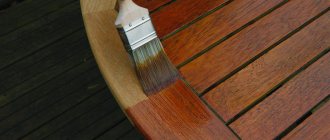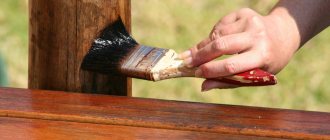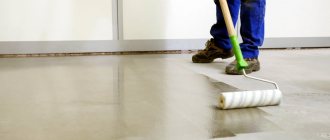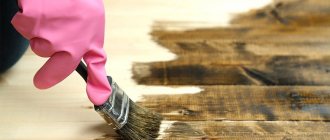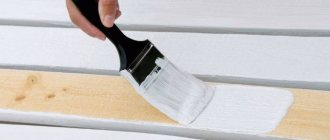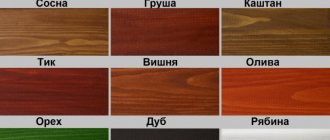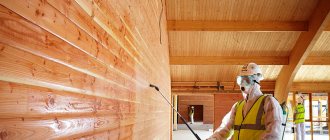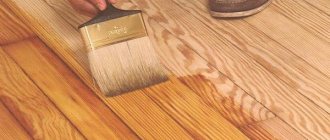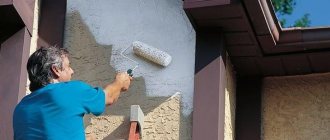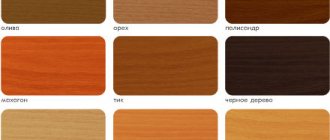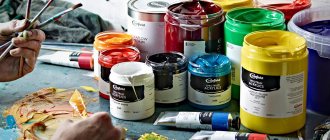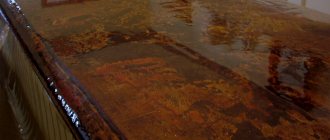Types of varnishes for wood - choosing the best for interior and exterior work
The varnish composition makes it possible to renew a wooden surface, which after a certain period of time begins to deteriorate.
Most people have decided to paint the wood, but in such a way that the natural appearance of the wood and its structure are not lost. There are many types of wood varnishes for this purpose. It is this coating that will help protect the wood from moisture, mechanical stress, and also from precipitation.
The products have an excellent composition, a large selection of colors and technical characteristics.
Mode of application
ZELEST VERESTA varnish is applied to a wood surface free of dirt, dust and coatings with a brush, roller, or sprayer in 1-2 (for wet or sunny conditions - 3) layers with intermediate drying for 45-60 minutes at normal humidity and air temperature not below +5 oC.
It is not recommended to paint in hot sunny weather to avoid reducing the absorbency of the composition due to premature drying. Do not apply to surfaces previously treated with drying oil! The color intensity and protective properties depend on the number of layers. Handle the ends especially carefully. The coating is produced in a ready-to-use form. Do not mix with other formulations. Stir before use. Under normal conditions, tack dry time is 1 hour. The final color is formed after complete drying!
Wood varnish consumption
The average consumption of varnish is 1000 ml for every eight to ten square meters of area. To apply subsequent layers, the consumption is reduced to 1 liter per twelve meters.
The following factors influence consumption:
- Type of tree. If the wood is considered porous, then the consumption of varnish for painting it increases;
- Density. Its consumption depends on the thickness of the varnish; the higher the viscosity of the substance, the greater the consumption;
- Wood processing. Well-sanded wood requires significantly less varnish than an untreated surface;
Color selection
Choosing a color scheme when tinting parquet is an important procedure, on which the style of your interior and its originality will depend. The standard oak color, made in yellow-brown tones, has already become boring to our compatriots
Therefore, more original shades, for example, smoky or stained oak, are becoming increasingly popular.
In addition, if you want to make your interior more modern and interesting, then you can choose a varnish in the color of bleached or blackened oak.
In addition, tinting allows you to make old floors more presentable. At the same time, the pattern and texture of the wood is completely preserved.
Optimal colors of tinted varnish:
- Dark, rich shades will give the floor an elegant and solid appearance. This coating goes best with warm, cozy tones. Most often, dark tinting is used in interiors designed in the Art Nouveau style. The most beautiful dark tones are dark chestnut, stained oak, chocolate shade and so on.
- White tinted paint material will allow you to emphasize your individuality. This kind of coating is at the peak of fashion today. Of course, a floor tinted white will not require particularly careful maintenance. On such a coating, dust will be almost invisible, unlike a subfloor. White tinted parquet will make your interior lighter and weightless.
- The brown tinted floor symbolizes comfort and reliability. This is a very versatile color as it suits almost any interior style. Brown varnish goes well with all shades of furniture, from yellow to dark tones.
- Gray tinted paint and varnish material will help make the parquet more elegant and solid. This color goes well with white and black interior elements. In addition, a floor covered with gray varnish will look good with cool and autumn tones.
- Dark red and cherry tinting will add coziness and warmth to your interior. At the same time, it will be more difficult to choose the optimal combination with other interior elements for this floor color. For example, such a floor goes perfectly with yellow, brown and green interior elements. At the same time, red tinted paint and varnish composition does not combine with cold tones.
Thus, tinting paint and varnish material will make parquet or any other wood covering more presentable and stylish. In addition, applying tinted varnish will make the coating more wear-resistant and durable.
Choosing a shade of varnish
Varnish can make the surface matte or give it a glossy shine. There are special compositions that give a strong gloss effect.
- The most popular is colorless varnish, which emphasizes the natural beauty of the wood.
- Walnut is used to create a variety of colors ranging from beige to black.
- White varnish will add visual volume to the wood.
Tinting varnish hides wood defects, making it darker.
Tips for choosing
The varnish for treating parquet is usually chosen by the client - on the advice of a parquet master who knows all the nuances
When restoring the floor yourself, it is important to do preliminary sanding and remove the old layer. It is incompatible with innovative new generation formulations
The intensity of the color may vary depending on the number of layers and the concentration of the color - it all depends on the preferences of the owners.
When choosing, it is important to consider the functionality of the room and the expected load. If the room will be rarely visited, walking in soft slippers on the bedroom floor, partially covered with carpet, heavy-duty film is not needed
It's better to be safe in the hallway. This includes outdoor shoes; abrasive particles will easily scratch the unstable coating.
You can give the parquet a pronounced gloss, which will act as a decorative element.In the dining room, kitchen or combined room, the parquet board should be impregnated with a primer and protected with waterproof LKS.
For non-residential premises in a large house (billiard room, wine cellar, dressing room, home cinema) a universal base is selected.
Varnishes used to treat the surface of parquet flooring for the purpose of protection are preferred by most consumers.
For a bar, small restaurant or cafe, where it is difficult to care for the parquet, it is preferable to treat the wood with wax mastic after careful sanding.
Surface preparation
During use, cracks, abrasions, scratches and other damage may appear on the surface of wooden materials. Particles of grease and dust that have penetrated inside can even change the color of the material, not to mention its texture. Therefore, preparatory measures are necessary. It is necessary to remove the top layer of coating that has become unusable before applying a layer of varnish to it.
It is also advisable to use a wood antiseptic to reliably protect the material from further destruction and pests.
The following methods are available for removing old coating:
- using a special wash method;
- by thermal exposure;
- mechanical action.
Removing the previous layer is a rather labor-intensive task and cannot be rushed. The first method involves applying a special product to the surface to be prepared. In this case, you need to use personal protective equipment. The material is covered with a film on top, forming a kind of compress. Evaporation occurs during the day, and then the old coating is removed with a spatula. The completely cleaned surface is thoroughly washed with heated water. Then it is sanded and a primer is applied.
As for the second method, here you can use a hair dryer or a blowtorch. When heated, the top layer softens and is then removed with a spatula. Good heat treatment is quite effective, but you need to monitor the heating temperature. During work, the room must be ventilated. It is recommended to wet the surface covered with an old layer of varnish or paint before starting heat treatment.
The mechanical method involves removing the outdated layer using a grinding machine or sanding with emery cloth. Only by cleaning and priming the surface of the material can the varnishing process be carried out. Using antiseptic agents to treat wood, you can protect it from destruction and damage by pathogenic microbes.
Scope of use
Based on the European Regulation C 2354 “Transparent coatings for wooden floors and varnishes made from them, minimum requirements and tests” of March 1, 2009, there are three categories.
| Category | Description |
| A | Intermittent use of the surface, infrequent loads of walking in shoes (rooms for receiving guests, kitchens, bedrooms). According to the wear resistance classification for laminated and linoleum coatings, it is similar to classes 23 and 31. |
| IN | Constant use of the surface, walking in shoes (lobby, corridors, school premises, universities, office rooms). Compliance with 32-33 wear resistance classes. |
| WITH | Increased exploitation (places with a large flow of people, supermarkets, hospitals, cafes). According to the wear resistance classification for laminated and linoleum coatings, it is similar to classes 33, 41-43. |
Regulatory document C 2354 does not contain information about the maximum possible level of impact from furniture wheels (tables, chairs). This is due to the fact that the ability to withstand the load of the rollers is directly dependent on the species and grade of the wood material.
There are several types of parquet depending on the type of use
When operating sports facilities and halls for physical activity, it is usually necessary to use varnish coatings that maximally protect the flooring from wear.
For example, the Petri series has an alkyd-based varnish composition with SPAR GYM technology, which is non-slip; in addition, it is able to protect the coating during intensive use, and does not interact with water during wet cleaning.
Which class of parquet is better to choose?
Differences between the compositions
Depending on the conditions of use of the wood base, the varnish can be used indoors or even outdoors. There are those compositions that dry quickly, are odorless, frost-resistant, thermally stable, water/alcohol/oil based and others.
According to the release form, they can be as follows:
- In cans (sprays/aerosols), which are convenient for covering a small area of wood.
- In containers (bottles and cans), which are applied with a spray gun, brush or roller.
By purpose:
- Floor varnish (parquet).
- For decoration and highlighting the beauty of wood structure.
- For water transport (yachts).
Next, it’s worth considering what color the varnish can be.
Kinds
Such attractive properties cannot be realized to the same extent by the same composition, which is why the chemical industry has launched the production of a significant range of varnishes. Water-soluble compounds have either a matte or glossy finish. In factories, a solution of dry emulsifiers in water is mixed using special equipment.
The formulation almost always includes additives that help form protective films on painted surfaces. One-component varnishes are created using acrylic or urethane compounds; two-component mixtures contain both at once.
Also, if necessary, you need to carry out regular wet cleaning using detergents and abrasives.
Therefore, the main objects of application of polyurethane coatings are:
- administrative and office buildings;
- educational institutions;
- trade organizations;
- healthcare, cultural and leisure institutions.
Acrylic varnishes have their advantages: they can and should be used where the priority is not wear resistance, but the elasticity of the created layer and its microventilation. These qualities are extremely important for living rooms with simple operating conditions. Regardless of the chemical composition, water-based varnish must be stored at positive air temperatures, otherwise it will deteriorate.
Panel varnish coating is a type of surface treatment using aqueous mixtures.
Compared to other options, this finishing material attracts attention with its impressive environmental and sanitary characteristics. Modern technologies make it possible to form a layer that has a pronounced tonality and is completely colorless in appearance.
The passage of steam is very important when finishing wood panels, since otherwise excessive pressure will be created inside the material. Other positive features of this option will be resistance to swelling, shrinkage and standard household pollutants.
It is convenient to use varnishes in aerosol format - and their protective properties are no worse than those of liquid packaging. The chemical composition is still the same: acrylic or polyurethane. After application there will be no problems with bad odor or long drying time.
Some aerosol varnishes are made on the basis of nitrocellulose, and within 60 minutes after surface treatment they become safe from a sanitary point of view.
Transparent balloon varnishes look harmonious even on expensive types of wood and do not spoil their appearance. If the base is made of cheaper wood or stone, concrete, brick, then you should choose a colored composition.
In cases where deep absorption into the surface is very important, it is not advisable to use water-based mixtures. Please note that treatment with aerosol varnishes can only be carried out outdoors or with intensive ventilation, away from open flames and sources of strong heat.
Varnish with sparkles has increased decorative capabilities. They can be holographic, rainbow or simulating the light of neon lamps. In the rays of reflected sunlight or electric light, such coatings look charming.
Stepping back a little, it should be mentioned that there is even a varnish for printed circuit boards. It is unlikely that anyone will consider these parts except repairmen and specialists. Therefore, they are coated solely to protect them from water. The required mixture is formed by mixing polyurethane and epoxy components, but technologists are actively working on obtaining simpler one-component mixtures.
Sometimes alkyd paint varnish is applied to the walls - in this case, the appearance of a smell will not be a critical moment
It is important to remember that alkyd and acrylic components do not tolerate each other. If they are used in any combination, then swelling will inevitably appear, and soon the painted surface will look completely ugly
The polyester composition is distinguished by the fact that it forms an insoluble film on the surface, the thickness of which ranges from 300 to 400 microns. For the most part, such mixtures are applied by spraying or pouring installations. If you polish the surface, it will quickly acquire a mirror appearance.
Glowing (luminescent) varnish for walls belongs to the category of specialized mixtures - such paints and varnishes create impressive effects, but it is recommended to entrust all work to professionals.
The marker option transforms any surface on which it is applied into the semblance of a real marker board.
Varnish variety
Varnish compositions are classified according to 3 criteria:
- place of application;
- by degree of gloss;
- by components in the composition.
Grouping by place of use
In order for the protective layer to last long and effectively, the varnish material is selected taking into account the place of application.
- Wood varnish for flooring is parquet materials. One of the larger groups. The leaders in it are considered to be: alkyd-polyurethane composition with one component, acrylic-polyurethane. These are universal LM. They can also be applied to doors and furniture.
- Thanks to decorative materials, wood receives decorative characteristics and is protected from external factors inside and outside the house.
- The structure of wood is emphasized with furniture varnishes in furniture production. They, like parquet ones, are used not only in their field.
- To protect floating craft made of wood, boat compounds are used. The coating is moisture-resistant, tolerates temperature fluctuations and exposure to aggressive environments. They are used to protect garden furniture and the walls of a laminated timber house on the street side.
Varnish materials by quality of reflection or degree of gloss
Based on the quality of reflection, varnishing materials are combined into 4 groups:
- high-gloss coating with a gloss level of 80-90%;
- gloss coating with a gloss level of 55-75%;
- for semi-gloss – 40-50%;
- Semi-matte and matte coatings reflect a small amount of light.
The manufacturer indicates on the container what surface will be created.
Classification by composition
The drying speed of the varnish coating and its protective properties are determined by the components in its composition. The main classification is grouping into groups according to composition.
- Alkyd varnish materials based on alkyd resins and organic solvent are in demand in everyday life. This is a varnish for interior woodwork. Rarely used for cladding wood bases outdoors. A durable, moisture-resistant, transparent coating appears. Its long drying period (3 days) is cited as a disadvantage. To reduce the time, components are introduced - special hardeners. The varnishing material is applied with a roller, automatic or pneumatic spray gun.
- An alternative to the alkyd composition is alkyd-urethane. The composition contains substances of the urethane group. This change led to a reduction in the drying time of the coating (from 6 to 16 hours). The covering layer has become more wear-resistant.
- Oil compositions consist of vegetable oils, organic solvents, and natural resins. They perform the primary coating of the wooden base. Its texture becomes colored after the material dries: from pale yellow to rich brown. The surface is covered with a hard film. It will be elastic for fatty varnishes (60-85%). In addition, the protective layer adds electrical insulating properties. The compositions are inferior in weather resistance to alkyd LM. Drying speed varies over a wide range.
- Nitro varnishes are used in closed areas. This is a mixture of colloxylin varnish, resins, plasticizers, and volatile organic solvents. It dries quickly and penetrates into the pores of the wood. The coating adheres tenaciously to the base and is durable. Due to the content of toxic substances in the composition, you need to work with the material in a respirator.
- Acrylic material is an environmentally friendly product. It is odorless and does not support fire. This is a universal composition, but is more often used for interior finishing work. The elastic covering layer preserves the color of the wooden base and its natural texture. Drying speed is faster than alkyd material. Although it takes 2 weeks for the film to dry completely.
- Epoxy varnish is a facing material for indoor and outdoor use ; it adheres well to wood. A durable, water-repellent coating is formed that withstands mechanical and chemical stress.
- Acrylic LM polyurethane composition is no less in demand. They are characterized by great resistance to abrasion, resistance to chemicals, and resistance to mechanical damage. The varnish coating is universal. It is applied to parquet floors and musical instruments. To achieve the desired effect from the coating, you must strictly follow the manufacturer's instructions. This is an important feature when working with the material.
- The alcohol composition is based on alcohol. The components of natural resins dissolve in it. Since alcohol tends to evaporate quickly, and resins dissolve slowly, the varnish is applied in multi-layers without fear of destroying the previous layer. The covering layer is polished, durable, but does not withstand exposure to water.
- Multicomponent polyester LM is applied strictly according to the instructions. A thick, hard coating film is formed. It repels water. The composition is used as the basis for the production of high-quality putty for cars.
Choosing a varnish for wood: important criteria
In order to reliably protect wooden surfaces, you need to know what requirements must be met for paint and varnish products. The varnish must have several main qualities, these include:
Wear resistance. Always choose your own material for different surfaces
For example, for wooden floors it is important to assess the level of expected load. If it is low, then the owners only need to purchase regular varnish
However, a large amount of furniture, the same traffic (for example, in hallways) are conditions that force you to choose a material that has increased wear resistance. Color or transparency. If the wooden surface has minor defects, then buy colored material, or add pigment to a colorless varnish. A small amount of dye will retain transparency, but will give the wood a light tint. Colorless compounds are recommended to be applied to elements of ideal quality. This is an opportunity to preserve the structure and appearance of a natural material. Components included. All varnishes are divided into one- and two-component paints and varnishes. In the first case, the solvent evaporates and the remaining material forms a strong film. In two-component materials, two ingredients react - a solvent and a hardener. Thanks to it, more reliable protection of the tree is guaranteed.
Equally important is the smell, or rather the lack thereof. Heavy, pungent “odors” will have a detrimental effect on the well-being of people and animals, so not all types are recommended for use in residential premises. For interior work, water-based varnishes are the best option. Any product is suitable for exterior finishing.
Other characteristics
These include:
- Shine. Using the material you can get both matte and glossy surfaces. In this case, the choice of varnish for wood depends on the preferences of the owners. Gloss gives the surface volume, and matte varnishes better highlight the texture of the wood.
- Fire safety. Heat-resistant varnish should be chosen if there is a risk of surfaces catching fire. Protection is especially necessary for those rooms where electric heating devices are located.
- Drying period. Many paintwork materials can take a very long time to dry; for others, an hour is enough. Therefore, the varnish must be selected depending on the surface being treated.
- Environmental friendliness is a mandatory requirement for premises, especially when wood is to be processed in children's rooms. In this case, there is only one option - water-based varnishes.
Choosing a varnish for wood with the current abundance is not an easy task, especially when it comes to the exterior decoration of a building. If you plan to purchase a material for treating wood indoors, then the best candidate is still a water-based varnish. These compositions are absolutely safe, but at the same time they have good technical characteristics and guarantee the aesthetics and durability of the coating.
To find out some more information about wood processing, it’s better to watch this video:
Varnishing wood
The principle of working with wood varnish is to apply it to the surface. As a result, the solvent contained in the substance will evaporate and a dense and shiny film will remain. These simple steps will help extend the life of the wood.
Of course, for an impeccable result, it is necessary to perform a number of preliminary measures. First, sand the wooden surface and remove any remaining old paint or varnish. After sanding, be sure to remove any remaining dust.
Secondly, it is very important to apply the primer varnish first. This will avoid the appearance of bubbles and prevent the formation of small defects.
Then you can apply the varnish, having previously chosen the desired tone. Thanks to the wide range of products on the sales market, you can choose the right color to match the interior of the room.
Areas of application of water-based acrylic varnishes
The high quality standards that water-based acrylic varnishes meet provide a wide range of possible applications. Similar compositions are used both in repair and construction, as well as in decorative and finishing works.
Let's look at the main areas in which varnish coating is used.
- For interior and exterior work in wooden houses, the most popular are glossy colorless and panel acrylic varnish. They are effective from an aesthetic and practical point of view, as they highlight the natural beauty of natural wood and reliably protect it. The coating can be washed regularly, it is environmentally friendly and does not pose a danger to the human body.
- Finishing of interior elements. Tables, chairs, sofa frames, stair railings - any pieces of furniture and other structures made of wood will last much longer if acrylic-polyurethane varnish is used for their treatment. The strength of the composition prevents the occurrence of minor damage, which is why polishing from the moment of application will be required no more than once a year.
- Strengthening the finishing of walls. One of the reasons why water-based varnish is so popular is its versatility in terms of surface material. Universal acrylic varnish is applied to painted walls, paper wallpaper, tiles and tiles. In all cases, the main goal is to create an additional protective layer that preserves the appearance of the interior walls.
- Parquet processing. As a rule, dense and rough boards are used to create parquet flooring, so for their processing it is better to choose matte colorless acrylic varnish on a polymer-acrylic base. It will provide a more durable coating that can withstand intensive use. Considering how long acrylic varnish takes to dry, you can treat all the floors in one room in just one day.
- To enhance the decorative effect of wooden or other products. Modern water-based acrylic varnishes are an effective material for the final stage of processing wooden or other products, capable of highlighting their beauty. When applied to wood, the composition actively penetrates the pores of the top layer and is securely fixed to the base.
- Protection of paintings. Don’t be surprised, professional artists, trying to extend the life of their masterpieces, often use a transparent acrylic composition as a protective layer. It does not affect the brightness of colors and protects them from fading. By the way, another option for creative use of acrylic varnish is decoupage. This design find involves decorative finishing of the interior with small drawings and patterns on paper.
Distinctive features
There are several varieties of such materials, the use of which depends on the area of application of wooden products and the requirements for their finishing coating:
| Polyurethane |
|
| Alkyd-urethane |
|
| Acrylic |
|
| Alcohol | When applied, they ideally adhere to the surface being treated, creating a durable coating that has a high degree of resistance to mechanical stress. But since the price of such compositions is not affordable, their scope of application is limited to use in the processing of musical instruments. |
White wood varnish can be applied with a brush
Preliminary preparation and working conditions
To apply the material to the surface, use a brush, roller or spray. In this case, the surface should be pre-prepared.
Tip: to achieve the desired result, the material should be applied in three layers.
Before starting work, the surface must undergo pre-treatment, the instructions are as follows:
- it is cleaned of old coating, as well as dust and dirt;
- after cleaning, the surface is polished;
- cover with a primer with your own hands, which can significantly reduce the consumption of the base material.
Tinted wood varnish Colorit
Tip: Repeated sanding after applying the primer will help give the surface an ideal smoothness.
To achieve the greatest efficiency, you need to ensure that the average air temperature indoors or outdoors is 20˚C, and the air humidity does not exceed 50%. However, each subsequent layer should not be applied earlier than every other day.
Coloring
Wood is a natural material that is easily damaged by adverse factors, which makes it very vulnerable. Therefore, products and structures made from it require increased protection, which can guarantee that they will last a very long time. One of them is varnish, regardless of whether it is colored or colorless.
Wenge wood varnish XB-784
As mentioned above, tinted material performs not only a protective function, but also a decorative one, giving the surface the desired shade. For this reason, it is not used on valuable woods such as beech or oak. For these purposes, colorless varnish, oils and other decorative and protective agents that can highlight the natural beauty of the wood structure are ideal.
Advice: since the use of tinted materials helps solve two problems at once, one of which is protection from damage, and the other is giving the wood a touch of nobility, they are used to process inexpensive species, such as pine.
Instead of paint
Gloss
In most cases, wood has a porous structure, which is characterized by good absorption. Therefore, even if you apply glossy varnish to an unprimed wooden surface, it will remain matte.
The second layer will not be absorbed as much, so the wood may receive the necessary gloss. If the structure of the material is highly porous, it will have to be applied in three or even more layers.
What colors of wood varnish are used?
If, after applying the first ball, the desired color is obtained, but there is no gloss, a colorless varnish is applied on top of this layer. In this case, the number of layers will depend on obtaining the desired degree of glossy shine.
White matte varnish for wood from Tikkurila
Texture
You can focus on the texture of the wood, that is, emphasize the natural pattern, by applying varnish to a surface that has not been previously primed. In this case, the decisive role is played by the different degrees of absorption inherent in individual sections of the tree.
The degree of absorption will significantly decrease when treating a surface coated with a primer, so this effect cannot be achieved. And if it is a colorless varnish, all efforts to provide contrast to the natural pattern on the surface of the wood will go to waste.
Color properties
- The initial color of the wood will be practically unaffected if the colored material is applied in one layer.
- However, each subsequent layer will increase the hiding power, leading to a smoothing of the textured wood pattern.
- If you use dark wood varnish, a thick layer of this material can give the same effect as paint. There may be a feeling that the desired varnish color does not match the actual one. For example, the sample indicated on the can looks as it should, but in reality, when the varnish is already applied to the surface, it may look different. This is due to the translucency of the varnish, which allows the natural grain of the wood to be visible.
In the photo - furniture varnish for wenge wood
- To obtain a lighter shade than that indicated in the sample, a thinner is used, which is the substances that make up the base of the varnish. For example, acrylic varnish is diluted only with water.
- You can get a darker shade if you apply the varnish in a thick layer. But here we must not forget that with an increase in the number of layers, the hiding power also increases.
- The final color of the varnish depends not only on the added color pigment, but also on the binders included in its composition. For example, the element added to bind alkyd varnishes is resin, which always gives the final color a yellow-brown tint. Acrylic varnishes do not have this drawback. The water included in their base cannot in any way affect the final color, therefore it always forms an absolutely transparent film.
Peculiarities
Varnish is a viscous solution designed to treat the surface of a material in order to create a reliable protective film. The treated surface can acquire a light or rich shine.
Lacquer coating was used for the first time in the 12th century by the German monk Theophilus. He strictly kept his recipe a secret; only many years later, during research, he learned that the varnish was created based on alcohol. Since the 15th century, oil-based products have appeared. England is considered to be their homeland.
It was only in the 19th century that the production of varnishes in large quantities began. Already in 1874, the Russian Osovetsky plant launched the production of oil varnishes of excellent quality. Later, other varieties appeared.
Technology of working with wood varnish
Work with varnish in dry weather without wind, the optimal temperature is from 15 to 30 degrees. It is important to take care of protective equipment - gloves, mask and goggles.
- The right tool. This can be a spray bottle, a brush or a construction roller. The most convenient tool is a spray bottle, which allows you to paint even hard-to-reach places.
- Prepared surface. A well-prepared surface will reduce varnish consumption. The wood must be sanded, all grooves and cracks are filled with a special wood putty.
- Using a primer. It gives the surface smoothness, which affects the consumption of varnish.
- Application process. Varnishes that are too thick can be thinned with solvent. It is necessary to apply at least two layers of varnish, this will consolidate the result and make the surface aesthetically pleasing.
Color spectrum
The main task of a paint coating is to create a durable coating and give it a color effect.
Using colored varnish has several advantages:
- protection from external factors;
- decorative function;
- the service life of the material increases.
Homeowners often purchase glossy varnish for their interiors - this applies to rooms that are quite dark. The clear look is one of the few examples where the natural structure of wood is emphasized through the application of varnish.
For example, by covering a parquet board with walnut-colored paints and varnishes, you can get several different color effects. It can be beige, red, black or dark brown.
Home owners also like to use tinting compounds. They cover doors, furniture, and parquet. The wood gains an unsurpassed appearance, as well as resistance to mechanical stress. Blue stains, fungus and mold will not form on this surface.
The main advantages of tinted varnishes
Some people prefer to use stains or oils to treat wood products, but tinted varnishes have much more advantages compared to such products. For example, tinting compounds can be applied extremely easily and quickly, and after some time a solution of a different shade can be applied, thereby changing the color of the wood.
To make the coloring of floor coverings or other wooden products much more intense, you just need to apply not one, but several layers of paint and varnish material for tinting. The more coatings are applied, the more intense the surface shade will be. In addition to its visual appeal, the wood tint varnish composition extends the life of the material to which it will be applied. Thanks to this varnish composition, it will be possible to simply and quickly restore old and worn-out wood.
Selection and Application
Not only saving time and money, but also the successful processing of the selected surface depends on choosing the right finishing material. Acrylic varnish is so unique and versatile that it can be easily used in any interior design with your eyes closed.
When processing wood, acrylic-based varnish has a practical and aesthetic effect. How much does it cost to treat a wooden floor? When working with a solid rough board, it is necessary to choose options that form the most dense layer. Also, such a coating should easily tolerate temperature changes and be resistant to moisture. Acrylic varnish for parquet was originally created so that the coating was thin, transparent and almost weightless, but if you cover rough boards with this type of varnish, the floor will soon crack. It is worth remembering that it will not be possible to quickly varnish the floor, because the first layer dries for at least 4 hours and at least 12 hours after finishing. In order to make life as easy as possible for the craftsmen, the acrylic floor varnish was initially made white. As it dries, it acquires perfect transparency, which gives a signal for applying the next layer.
For exterior work, applying this product as a finishing coat is also applicable. Resistant to sudden changes in temperature and mechanical damage, it allows the surface to retain its original pattern and shade.
Smaller projects also need acrylic varnish treatment. For example, it is very convenient to use it to cover stools and bedside tables, stairs, railings and plasterboard walls, table tops, decorative interior items (figurines, frames, and so on). Even painting requires treatment - it is worth covering the picture with acrylic varnish so that it will delight you longer with its bright, pristine colors.
Due to the high cost of acrylic varnish, there are several ways to make your own wood varnish at home. The oldest and most common method is mixing acetone and foam. The consistency is jelly-like, not the most convenient for application, but its durability and wear resistance are not inferior to store-bought ones. This mass can be used to treat small areas of the surface or to apply a protective layer to homemade interior decorations.
Another creative area for using acrylic varnish can be considered decoupage - decorating various interior items with pieces of paintings, drawings, ornaments and paper-based monograms.
Criteria affecting material consumption
The consumption of LM is influenced by several criteria:
- Wood porosity. Wood with small pores (beech, pine) is treated with less varnish than surfaces with deep pores (oak, ash).
- Thoroughness of grinding. For this, sandpaper with a grain of 100 is used. High-quality work reduces the consumption of varnish material. Before applying the next layer, use 220 grit sandpaper.
- Consistency of the composition. Thick ones are consumed more. To reduce costs, before applying the first 2 layers, the composition is diluted with a solvent. Water based, diluted with a small amount of liquid.
- Application technique. Using a sprayer as a working tool reduces consumption. Application with a roller or brush increases it. On average, 100-125 ml of varnish material is consumed per 1 square meter of wooden surface. To cover the second layer – 80-100 ml/m2. The exact consumption of each type is indicated on the can by the manufacturer.
Classification of varnishes for parquet boards
Paint and varnish products are classified according to different parameters:
- Method of application: there are varnishes for exterior and interior use.
- Technological properties - viscosity, hiding power, fluidity, method of application.
- The ability to tint wood (completely colorless, giving additional richness to the texture, colored and dark pitch varnish with a golden tint).
- Resistance to stress and abrasion, resistance to adverse conditions, chemical reagents and temperature fluctuations.
- Duration of operation.
- Chemical composition (on different bases) and polymerization method.
- Degrees of light reflection (matte, glossy, velvety, silky, semi-matte varnish).
- Environmental safety and recycling options.
Coloring rules
Before tinting the surface with such varnish, the product is thoroughly mixed.
The suitable tools are a roller, brush or sprayer; the base must first be prepared. It must be dry and clean.
Before painting, the surface is sanded and scraped (depending on the type of parquet).
If the tinting substance will be applied to a base made of mineral material, then first you need to apply a layer of varnish for priming; for this it is diluted with water in 1:1 proportions.
You need to varnish two or three times. The next layer will always be applied when the previous one has completely dried. To prevent the product from thickening, stir it periodically during staining (once every 30 minutes).
When working with tinting material, it is important to maintain a room temperature of about 12 degrees Celsius.
After painting is finished, the tools are cleaned with water, otherwise the varnish on them will dry out and become hard.
